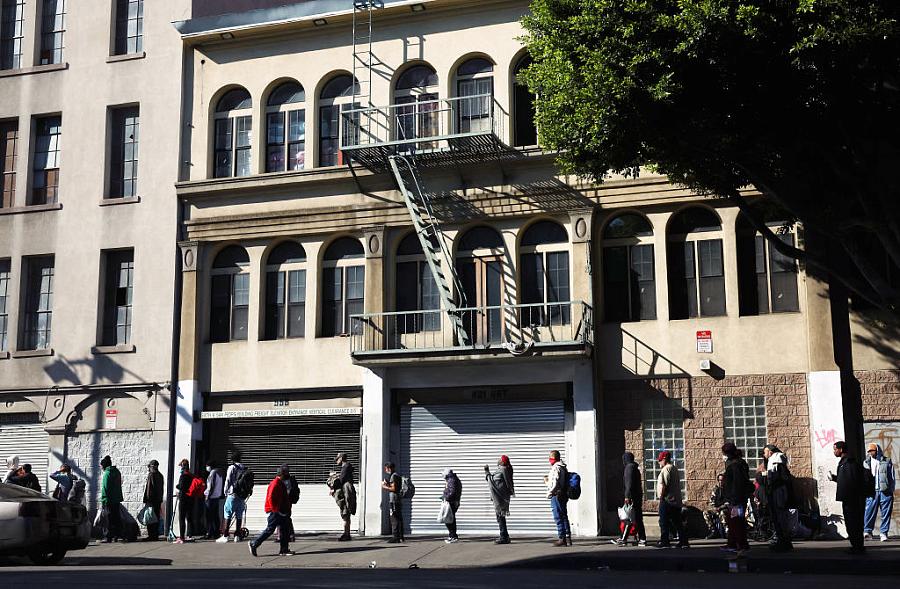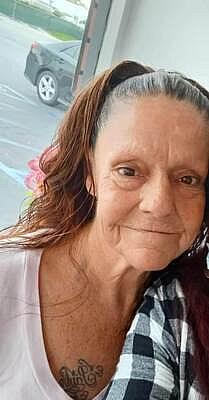A deeper understanding of trauma proves essential for reporter telling the story of an unhoused woman

People wait in line to collect a free meal in the Skid Row area of downtown Los Angeles.
Photo by Mario Tama/Getty Images
I remember sitting in an editorial meeting for the National Fellowship, and telling everyone about my plans to write a story that would reconstruct the life of a woman who had died in homelessness.
“That’s going to be awfully tough,” another reporter said. My quick retort: “I thrive on challenge.”
But his words haunted me. How exactly was I going to find enough details to rebuild the life of an unhoused woman who, given that she had spent the majority of her life on the streets, had a small and thin support network?
I knew that I wanted the focus of my piece to be about how trauma — and the lack of corresponding trauma awareness for people experiencing homelessness — is a significant reason so many people die early deaths on the streets.
The life expectancies of the more than a million people living on the streets and in shelters on any given night in this country are nearly 20 years less than those of their housed counterparts. Meanwhile, the number of people dying while unhoused has increased dramatically in the past five years, according to an analysis by the Guardian performed in conjunction with an academic expert at the University of Washington. The analysis examined 20 urban U.S. areas, discovering that deaths of people living without housing had shot up by 77% between 2015 and 2020.

Denise Lerma
I found Denise Lerma, the protagonist of my project story, through connections shared with me via a source I had worked with for more than five years. He is well known in national circles that work to solve homelessness and he pledged to help me find someone for my article because he believed I would tell a story bureaucrats in the homelessness industry needed to hear: particularly, what trauma awareness actually means. The term “trauma awareness” is often bandied about, especially since the days of COVID-19, when the term seemed to become ubiquitous. Yet few seem to grasp the dynamics that actually define it — namely, the practical empowerment of the individual being served.
Sadly, Denise Lerma did not receive that kind of empowerment until it was too late. She died in the context of reversible but unhealed trauma, because no one was able to empower her within a health care system determined to diminish her. My original source for my project didn’t know Denise had existed. But he had heard so many stories about people who had died because of a lack of trauma awareness that he wrote at least a dozen letters to boots-on-the ground professionals who, in turn, knew unhoused people who had died in homelessness. The title of his emails: “Introduction to a trusted reporter.”
Thus, my first tip to reporters attempting to find hard-to-find subjects for big, project stories is to develop long-lasting relationships through which you prove you can be trusted. Earning the trust of people experiencing homelessness, is especially difficult, as the trauma such individuals have experienced — from their homes being demolished by police to being overlooked for necessary medical treatments by physicians who view them as one-dimensional stereotypes instead of patients who need customized care — causes a justified fear of anyone in a position of power.
As a self-labeled “trauma-aware journalist,” I go above and beyond to read my unsheltered sources’ quotes back to them before publishing a piece. I do this because I know that the root of trauma is powerlessness, and the relationship between a reporter and a source can easily weight any perceived power imbalance toward the reporter.
Jackie Guzman, Denise’s older sister, was a critical source for the story. She helped me understand Denise by sharing painful memories from their childhood. At times during our interview, Guzman told me she might want to retract her part in the story altogether, as she did not understand how “sharing her family’s dirty laundry” could possibly help anyone. When this happened, she and I started over. We recalled our joint purpose in helping readers replace judgment of the unhoused with trauma-awareness.
Yes, that meant delving into adverse childhood experiences, but it also meant putting them into the context of a society that generally does not acknowledge nor heal them, particularly for Black and Brown children who then go on to disproportionately constitute the unhoused population. In the end, Guzman told me she was proud of her sister’s story, that it meant her sister’s death could make a positive difference in this world.
Other important people who helped me reconstruct Denise’s life included two people who lived in homelessness with her: her former boyfriend, Paul, and her friend, Louis. Both had lived in a tent encampment with Denise in Lincoln Park in Los Angeles. I found Paul in the park, on a hot afternoon in June.
At first he didn’t want to talk. But then a street team physician that my source had convinced could trust me persuaded Paul he could trust me. Eventually, Paul told me about the last time he saw Denise, a day when she bought him a new T-shirt, took him to get his haircut, and chided him for not taking better care of himself. Then, after showing me where he and Denise had lived in a tent by the railroad tracks, Paul told me I could use his first and last name. This moment came as I asked him to show me some of Denise’s belongings that he kept as keepsakes — a hot pink blouse she had loved, and a wooden placard that he had hand-carved with their initials. I believe that was a pivotal moment for him because I was genuinely interested in their romance and he felt that.
I’m not sure if encouraging reporters to care about the unhoused is a viable tip. After all, one cannot feign caring. But what I can encourage reporters to do is to spend time with the unhoused, to ask questions to answers that you really want to hear, and then truly listen to what is said. Admittedly, this is often easier said than done, as people experiencing homelessness are often found in some rather truly horrible situations — places every cell in our bodies may be telling us to avoid.
This was certainly true of the tiny hotel room in which I met Louis, at the infamous Cecil Hotel on Skid Row in Los Angeles. When I walked into his room, a nurse was there from the USC Street Medicine, a team of medical professionals and other workers who care for people living on the streets. Louis’s pants were pushed down toward his ankles, exposing an oozing ulcer on his right leg. The room was tiny and its one window was shut tight. As the nurse tended to him, I interviewed him, doing my best to not show my discomfort at watching the nurse clean the wound.
As Louis and I talked, he shared with me how much he cherished his friendship with Denise. She liked to walk up to him at the encampment and hand him balloons, he told me, because she liked to see him smile.
“What color was the last balloon she gave you?” I asked him.
“Pink,” he said.
It turned out to be a single detail in a sentence at the beginning of the fellowship story that followed, “Denise’s Last Days.”

